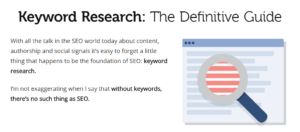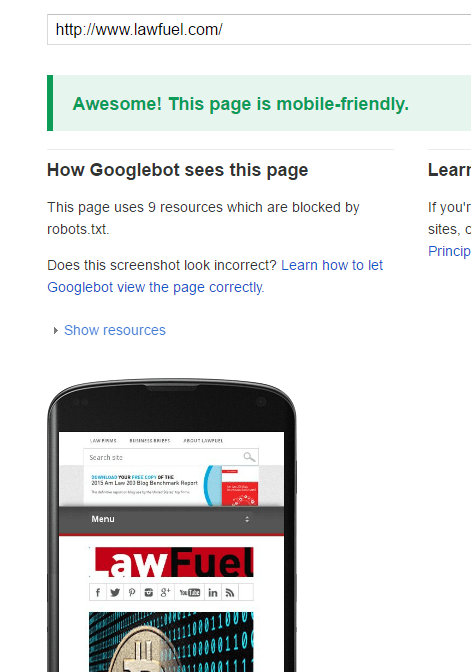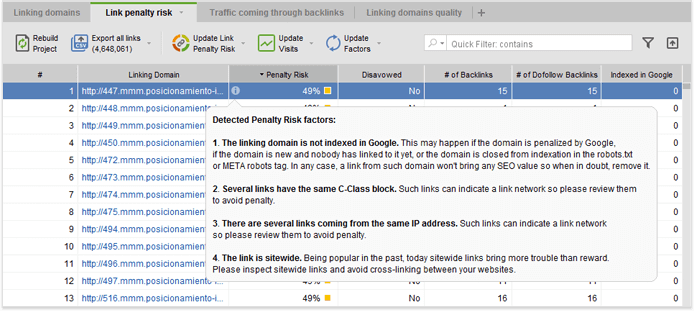
LawFuel looks at some of the ‘quick fixes’ law firms can use to fix their SEO to ensure they’re getting maximum conversions from potential clients – which means achieving good rankings for their search terms and a website that is properly optimized.
We know that search engine optimization isn’t ‘quick’ or ‘simple’ by definition. Many things in SEO will take plenty of time and effort — think taking your site mobile, building links, or moving to HTTPS. But then… there are some SEO tweaks that really are both quick and effective. In this article, I’ve put up my top 10 list of the most worthwhile SEO fixes you can do in under an hour.
These simple hacks won’t take you to the top of Google if you neglect the more time-consuming (but necessary) components of the search engine optimization process. But combined with your main efforts, they are sure to make a difference in your search engine visibility and traffic, and give you that ranking boost you may be just needing.
You should also check out how “search” actually works and the best person to explain that may be one of Google’s top search gurus, Matt Cutts.
Check the video for that here –
Technical SEO
Remember too that when you’re fixing SEO for your law firm (or any other site) keep it “white hat”. You’re a lawyer, so stay within the rules and avoid the stuff that Google and the other search engines will punish you for.
What’s the difference between ‘white’ and ‘black hat’?

So while content is king, we’re focusing here on some of the things any lawyer using WordPress (or not) can do to make sure they are fixing their SEO for maximum impact online.
Check these:
1. Re-Fresh Your Content
While fresh content is one of the very best ways to achieve great rankings, you don’t need to endlessly write to do so.
Two fast ways to achieve great rankings is to:
- Provide in-depth content. Rather than writing fast pieces and updates, you should try and provide the most indepth content that will then let your clients (and potential clients) fully understand what you are doing and saying – something that’s key for those seeking an explanation of the law.
- Refresh and update your existing content. Cases and legal issues are ever-developing ‘moving feasts’ so by updating content and bringing it into the ‘now’ will still count as new content.
The reality is that using good content and updating it can be as effective as publishing new content.
You can also add features, optimized images (with keyword descriptions) and even add features like a Q&A on the specific topic.
All these features will ensure your content is regarded as ‘new’ by Google and picked up for extra attention and readership.
2. Use the Right Words
In the good-old, bad old days “keyword stuffing” – the repeated use of keywords in content – was the simple way to achieve top rankings.
Now it is the simple way to get slapped by Google.
What has to happen with your content now is to use semantics and related keywords, including long-tail keywords and geo-targeted keywords that will help with your rankings.
If you’re struggling to get the right keywords or unsure about how to go about finding the keywords that might help an attorney reach their target market, then check the ver good backlinko blog reference book (for free) – 
For instance, you’re a Pittsburg-based divorce lawyer – let’s look at what Google will show for related keyword phrases based upon what you have entered in the search bar and see what Google suggests –

. . or you’re an Orange County Injury lawyer – what should you be ‘optimizing’ for –

When looking at content you need to always be aware of what your potential clients might want or need.
You’re writing for them and if you write it clearly (cut the jargon and legalease) and prodfuce the best quality content possible you will be able to generate high Google traction and views.
If you want to develop ideas on how to develop your content (existing or new) then you may want to check this great resource from OKdork.
3. Sort Your “Code”
Now we know you’re not a coder or some nerd able to dabble with your computer code, but you don’t need to know all that in order to get the basics of HTML right.
There are some great places to learn about HTML for free if you wish, such as Codecademy or Khan Academy, and there are also some great ‘fast start’ places such as those using a simple cheat sheet, like this one.
Here are the 4 key components you need to know –
1. The Title tags
Your website’s title tags are the online equivalent of newspaper headlines. They are what shows up in the tab of your browser when you open a new page.
The HTML tag used for them is called title, but in case of blogs it often becomes an h1-tag, which stands for heading of the first order.
Every page should only have one h1-tag to make the title clear to Google. We’ve shown you how to do this in Quicksprout University, but the website First Page Sage has compiled a few more things you can do to get these right.
2. Meta description
Meta descriptions are what shows up as an excerpt when Google displays your page as a result to searchers. It’s easy to spot who’s done their SEO homework and who hasn’t:

Optimized results will never be cut off and end with “…” or seem like they end mid-sentence. They also often mention their keyword up front.
You can learn how to come up with great meta tags in Quicksprout University, and should also check out some good examples to get a feel for descriptions.
Don’t overthink this 160 character text snippet though. When writing it, you shouldkeep the searchers in mind, much more so than the search engine.
3. Schema
Don’t get frightened.d “Schema” is one of the backbones of SEO success and is something various search engines developed to help themselves and you.
Essentially it is a specific set of html tags that helps display your content to the engines.
The rating from the above example with Bitcoin was created using Schema, for example. It’s a rather small factor, but definitely good practice.
Moz has some good tips on working with and maximizing the advantages of Schema. Once done you can then test your page to make sure everything is fine and your page is fully ‘Schema-optimized’ for great display.
4. Subheads
Using subheads and descriptions about your content is one of the simplest and most effective things you can do to help build your firm’s SEO effectiveness.
It is one of the best things you can do with a WordPress site.
The reason subheads are critical is that they help the structure and format of your content and provide very good reference points for content.
Legal content and articles can be often complex and difficult to read – breaking up content to make it user friendly also makes it SEO-friendly so make sure you provide logical and simple subhead breaks.
The sub-heads do not have the power of h1-tags, but using h2, h3, h4 tags are important, simple and still very effective.
Check this recent case study by Search Engine Watch is a great story of how a few title and meta description tweaks can improve the entire site’s click through rate by 20%.
There are plenty of ways to optimize your Google snippet for more clicks.
You may wish to mention your special legal services or expertise in a particular area.
Take a look at your law firm competitors’ search engine listings and think of something that will make yours stand out and create that key point of difference.
And use keywords properly to ensure you are properly describing what you’re doing and how you do it.
Once you’re happy with your snippet, hit Save page to save the upload-ready HTML file to your hard drive.
4. Get Your Sitemap Working
The sitemap is critical to the success of your site. You want to be crawled and indexed and ranked.
All of which points to your sitemap being in good shape.
If you actually want to see a sitemap crawler in action you can check this free tool and watch.
For WordPress you can use this very good sitemap plugin to do the job for you or your can use an xml sitemap generator.
Whenever your law site has new content added you let the search engines index your site and if its original, the search engines will also know that it is the original.
You should check your sitemap now to make sure the key pages can be found, including the newer pages.
If you don’t have your sitemap submitted to Google then do it! Simple and easy via the Submit button in the Search Console (see below).
You can – if you’re a WordPress law firm site – use a good plugin or tool such as SEO PowerSuite Website Auditor.
And to have your site crawled easily you can check some content like this.
One thing you can do to make web crawling easier for your firm site is to interlink content, which gives a better understanding to Google and the other engines as to what your site is about.
For instance, if you’re a bankruptcy attorney writing about a recent decision, you should link to other relevant decisions or advice rather than simply publishing the standalone article.
Check Google Search Console
Google’s Search Console will tell you if there are errors. It simply requires that you login in and begin the process.
You need to go to Crawl > Sitemaps.
At the top right you’ll find an Add/Test Sitemaps button.
Simply click on the Test Sitemap button, plug in the URL of your sitemap, and click Test:

Following completion you will see your test results, which will show what (if any) problems you may have.
When the test is complete, you can view the results by clicking on View test result. This will reveal if Google encountered any errors when parsing your sitemap (if that’s the case, you’ll see a list of problems to be fixed). If the test is successful, congrats! Your sitemap is clean and ready for upload.
Bing Submit
Don’t overlook Bing, which is a major search engine and can generate some significant traffic for your law firm.
To submit to them, you need to log into Bing’s Webmaster Tools, and under the Sitemaps widget, click on the Bing Submit a Sitemap.
This will reveal a URL field in which you can enter the location of your sitemap file.

You can also use a site audit to see what is wrong with the site, which can also include a link check to make sure you can do a check on your llinks to spot some of the potential penalties that can occur if your law firm doesn’t link correctly.
If you want an in-depth guide on link-auditing, here’s one
5. Make Sure You’re Mobile-Friendly
We’re mobile-mad, you know it. The fact ids that around half a billion (that’s a big number) Facebook users will use only their mobile devices to access their accounts and news feeds.
Which means you have to be receptive to that group.
You need to take Google’s Mobile Test and check out your ‘friendliness’ on the mobile  devices, which will then bring up your result –
devices, which will then bring up your result –
If you have issues optimizing your site you can use a useful WordPress plugin.
The key point here is to ensure you’re developing leads via mobile-optimized web traffic given the vast reach through mobile devices.
6. Improve Your Page Speed
Page speed is one of the key factors for ranking well with Google. If your site is slow you are punishing your business – fewer conversions, fewer client enquiries.
According to Kissmetrics, as little as a 1 second delay in page loading time can result in up to 7% reduce in conversions for your site – and that is a lot.
However you can easily check the position and optimize your site properly to create the necessary improvements.
Check out some of the free resources showing how yhou can improve site speed, including:
If you use the WebSite Auditor tool you can open your project and go to Content Analysis.
And you can also use this useful tool to identify what the low hanging fruit are that can help speed up your site.
Click Add page, specify the URL you’d like to test, and enter your target keywords. In a moment, your page will be analyzed in terms of on-page optimization as well as technical SEO. Scroll to the Page Speed (Desktop) section of on-page factors to see if any problems have been found.
Once you correct your site speed you can also request that Google re-crawl your site.
Just go the the Search Console on Google and go to Crawl > Fetch as Google. Enter the URL of the page you want to be re-crawled (or leave the field blank if you’d like Google to crawl the homepage) and click Fetch.
You’re done.

Note that your fetch must have a complete, partial, or redirected status for you to be able to submit the page to Google’s index (otherwise, you’ll see a list of problems Google found on your site and will need to fix those and use the Fetch as Google tool again). If Googlebot can successfully fetch your page, just click the Submit to index button to encourage Google to re-crawl it.

You can submit either the exact URL to be re-crawled (up to 500 URLs per week), or the URL and all pages linked from it (up to 10 per month).
If you choose the latter, Google will use this URL as a starting point in indexing your site content and will follow internal links to crawl the rest of the pages on your site. Remember that Google doesn’t guarantee to index all of your site’s pages, but if the site is fairly small, it most probably will.

There’s a similar option in Bing Webmaster Tools, as well. You just need to locate the Configure My Site section in your dashboard and click on Submit URLs. Fill in the URL you need re-indexed, and Bing will generally crawl the site within minutes.
7. Correct Duplicate Content
Having duplicate content is a Google “no-no” so you need to ensure you are not penalized because of it.
You can check for duplicate content, for instance by using this tool from SEO Moz.
If you open To run a quick duplicate content check, open your WebSite Auditor project and examine theOn-page section of SEO factors in your site audit.
Check your site for duplicate titles and meta descriptions. If any are found, click on the problematic factor to see where the duplicate content occurs.

Now, you’ll need to take a look at the problem pages to see whether the duplication only occurs in the titles and/or descriptions, or if all content on the pages is duplicated.
If it’s the former, all you’ll need to do is rewrite your titles.
You can do this by going to Content Analysis > Content Editor and switching to the Title & Meta tags tab.
If the page’s content is duplicated too, you’ll need a different approach.
One of the best ways is to set up a 301 redirect, which means you redirect from the duplicate content page to the ‘original’ page. You can read this here.
But don’t avoid re-posting your own content to other major sites, like Medium.com. However be aware that you should set up the 301 redirects or
8. Turn Relevant News and Brands Into Links
You can do a quick audit of backlinks to ensure you’re not being penalized, but you can also develop ways to create powerful links back to your firm site.
To check backljinks and to ensure you’re not being penalized you can use a tool like SEO PowerSuite‘s SEO SpyGlass and create a project to your site.
When the app has collected your backlinks, switch to Backlink Profile > Linking Domains and go to theLink penalty risk tab. Select all domains in your workspace and hit the Update Link Penalty Riskbutton to calculate how risky the links from each referring domain are.
The site will also show you a list of factors that make this link potentially dangerous.

If you do find a few spammy links you need to disavow, go on and add them to your disavow file. To do that, select the risky linking domains, right-click the selection, and hit Disavow Backlinks.
But to build powerful backlinks and avoid the time and labor-consuming intensity of finding them, use tools.
A top one is Google Alerts and Awario, which can save you massive amounts of time in discovering those content ideas.
Awario has a free trial, and the sign-up takes nothing more than your email address
With Awario, you can use your own law firm brand as keywords (make sure to not include your site’s URL). In a moment, your dashboard will populate with mentions of those keywords across the Web.
You can create an alert from attorney competitors with their firm names and keywords for the area of legal specialty they (and you) want to develop clients for.
Very quickly you’ll see a feed of mentions of those brand names (as well their posts on social media). You can sort those mentions by the number of people that are exposed to each by clicking on the three dots in the right upper corner of your mention feed. This will let you see which of their content has done best — and get inspired for your own next piece.
Isolate those that don’t have a link to your site, and contact the webmaster and ask them for a link instead. They are mentioning you already, so they usually wouldn’t mind.
Conclusion
There are changes occurring constantly in SEO but there are also tools you can use to enhance your efforts to project your law firm higher up the search engines by dong some smart things using smart tools.
Let us know how you go – or if you need any feedback on your efforts.
>> Also check this useful article from CloudLiving on speeding up your WordPress site following these 22 tips





